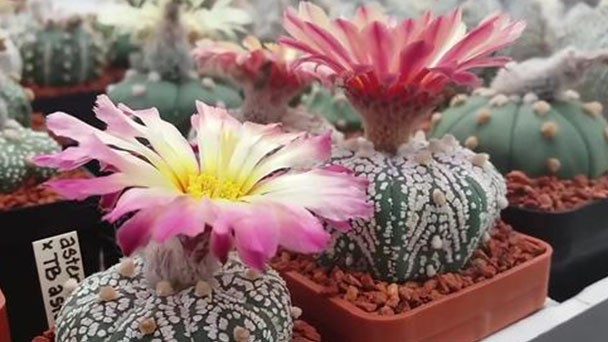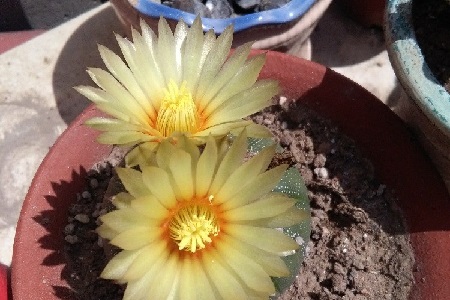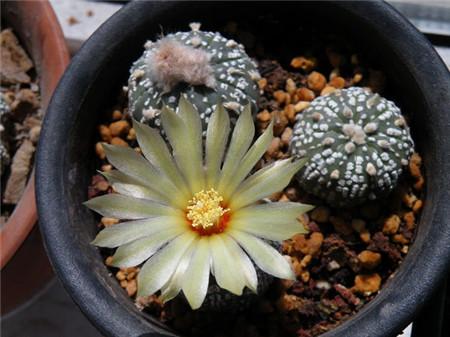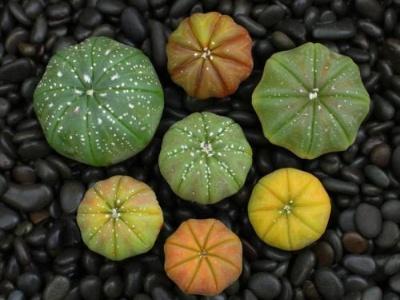Astrophytum Asterias profile
Written by Maggie
Aug 27 2021

Astrophytum Asterias are native to the southern United States, northern Mexico, northeast and central Mexico.The plant is oblate and spherical, with a diameter of 5 ~ 8cm, and the sphere is divided into 6 ~ 10 oblate edges by 6 ~ 10 shallow gullies. Spines are free, white stellate woolly on spines. Flowers born on top of a ball, funnel-shaped, yellow or red, flower-centered red. Astrophytum Asterias are perennial cactus plants, hemispherical, slow growing. The height is 8 ~ 10cm, and the crown diameter is 10cm. Stems are spiny, ca. 8 low ribbed, with small clustered nests on rims. Flowers are bright yellow, up to 6cm in diameter, open in summer.
Astrophytum Asterias picture

Astrophytum Asterias morphological characteristics
Astrophytum Asterias are oblate, with a diameter of 5 ~ 8cm, and the sphere is divided into 6 ~ 10 oblate edges by 6 ~ 10 shallow trenches. Spines are free, white stellate woolly on spines. Flowers born at the top of the ball, funnel-shaped, yellow, multicolored, 3 ~ 4cm in diameter.
Astrophytum Asterias distribution
Astrophytum Asterias are native to the southern United States, northern Mexico, northeast and central Mexico.
Astrophytum Asterias method of cultivation
Astrophytum Asterias prefer dry, drought-tolerant, sunny, and well-drained sandy soils rich in limestone. Water frequently during the growing season. Adult plants can be changed every 5 ~ 6 years. When the temperature is lower than 7℃ in winter, it can be placed indoors at night to keep warm. To propagate by sowing, cutting, or grafting. Culture requires good drainage, rich in limestone sandy loam. Be cool in winter and keep the soil dry. The summer requires plenty of sunshine and regular watering. Potted plants should not be too deep, the bottom can be filled with broken tiles to facilitate drainage. The growth of astrophytum asterias self-rooted seeded seedlings is very good. However, in order to accelerate the growth of spheres in cultivation, grafting is still often used. Grafting of seeded seedling can blossom the year following Hylocereus undatus. Various (varieties) plants of the same genus and planet are of peculiar shape, simple cultivation and easy flowering, and the offspring of artificial pollination after flowering are of great variation and high ornamental value, which often arouse the interest of cultivators, and are often used for potted ornamental.

Astrophytum Asterias method of reproduction
Astrophytum Asterias are commonly seeded and grafted. Sowing: indoor basin is often used in spring, 3 ~ 5 days after sowing germination, solid seedlings 3 ~ 4 years later can blossom. Grafting: in May to June, commonly used flower ball or measuring day ruler as rootstock, scion with sowing seedlings, then the second year can be flowering.
Astrophytum Asterias should be watered frequently during the growing season. Adult plants can be changed every 5 ~ 6 years. Astrophytum Asterias is often seeded and grafted.
sow
Astrophytum Asterias usually adopt indoor basin sowing in spring, germinate 3 ~ 5 days after sowing, and germinate seedlings 3 ~ 4 years later.
grafting
Astrophytum Asterias are carried out from May to June. Flowers are usually filled with balls or measuring feet as rootstock. Scions are seeded with seedlings and then blossom in the second year.
Astrophytum Asterias disease control
Astrophytum Asterias, which are mainly harmful to gray mold and scab, were sprayed with a solution 1000 times of 70% methyl topazin wettable powder.
Astrophytum Asterias insect pests are mainly harmful to red spider mites, which can be killed with 40% oxy dimethoate butter 1500 times liquid spray.

Latest Updated
- Benefits of Bugleweed - 7 Science-backed Health Benefits
- Bugleweed Dangers & Side Effects - Is It Poisonous?
- How to Plant Evergreen Trees - What You Should Know
- When to Plant Evergreens - Grow Guide for Evergreen Trees
- 12 Wonderful Evergreen Shrubs for Your Garden
- 12 Popular Evergreen Plants with Pictures for Beginners
- When And How To Prune A Lilac Bush Like a Pro
- How to Grow & Care for Lilac Vine (Hardenbergia Violacea)
- Japanese Lilac Tree (Syringa Reticulata) Care & Propagation Guide
- Shumard Oak Pros and Cons - What to Know
Popular Articles
- Winter maintenance of Antirrhinum Majus
- How to Grow Terminalia Mantaly Tree
- How to Grow and Care for Crossostephium Chinense
- How to grow Antirrhinum Majus in spring
- Peristeria Elata (Dove Orchid) Profile: Info & Care Guide
- Underwatered Snake Plant (Sansevieria Trifasciata) - Signs And How To Fix
- How to Care for Brazilian Jasmine Plant (Mandevilla Sanderi)
- How to Grow & Care for Graptopetalum Purple Delight in Summer
- Rosa Chinensis (China Rose): Plant Growing & Care Tips
- How to Care for Baby Sun Rose (Aptenia Cordifolia)